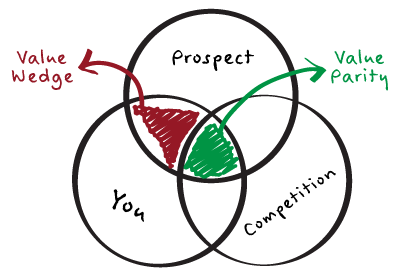Timothy Riesterer's Blog, page 16
January 3, 2017
Prospect Theory…And How It Can Transform Your Executive Conversations

All of your road warriors have lived through this. I was in the airport terminal last week getting ready to board my flight home when an announcement came from the customer service desk: The flight was overbooked. The airline was looking for a volunteer to give up their seat and take a later flight home, in exchange for a $500 voucher they could apply to their next trip.
For a small inconvenience—the next flight to the same city was leaving in a few hours—the airline would give some willing passenger the chance to make a significant monetary gain. And yet the announcement was made, and it was followed, predictably, by crickets. No one budged. “Thanks, but no thanks,” was the collective mood in the terminal. Everyone there, myself included, was just fine with the ticket we already had. All of us had made the calculation that what we had in our pockets—a ticket home at the time we’d planned for—was more valuable than a small delay, plus a $500 voucher that might cover much or all of the airfare for our next trip or vacation.
This scene in the terminal is loss aversion in action.
Let me explain why understanding how this principle works can transform how you engage with executive decision-makers—and how new research proves it.
Prospect Theory
When the social psychologist duo Daniel Kahneman and Amos Tversky tested the concepts of loss aversion (our resistance to losing what we have) and risk-seeking (our willingness to take risks), they reached a fascinating conclusion about decision-making: They found that humans are two- to three-times more likely to make a decision to avoid a loss than they are to make a decision to attain a gain. This is known as “Prospect Theory.”
So, what many airlines may not know when they ask volunteers to give up their seat on an overbooked flight is that they’re actually trying to override a powerful decision-making instinct. When humans have something, they are none too inclined to give it up—even if “the math” says they should.
Some of my Corporate Visions colleagues and I found the concept of Prospect Theory compelling, but were still wondering how much of an influence it had on executive decision-makers, long regarded as strictly rational people, unswayed by emotions.
Collaborating with Dr. Zakary Tormala, an expert in messaging and social influence, we recruited 113 executives from a range of industries and asked them to participate in an experiment designed to test whether Prospect Theory applies in an executive selling context. Turns out, it does—big time. What the experiment also showed is that you can make an emotional impact with executive decision-makers that can sway deals in your favor…but only if you frame your conversations appropriately.
In one of the three scenarios we tested—a business decision-making situation—we split participants up into two different conditions, which were mathematically identical but framed differently. To begin, all participants received the following instructions:
“The following question asks you to choose between two courses of action when facing an economic downturn. Please read the question and choose one course of action: A large car manufacturer has recently been hit with a number of economic difficulties and it appears as if three plants need to be closed and 6,000 employees laid off. The vice president of production has been exploring alternative ways to avoid this crisis. She has developed two plans.
Following this overview, participants received information about the two options. The options were mathematically identical across the gain and loss frame conditions. Importantly, though, they differed in whether they were framed in terms of gains or losses.
In the gain frame condition, the options were described in terms of how many plants and jobs would be saved:
Plan A: This plan will save one of the three plants and 2,000 jobs.
Or…
Plan B: This plan has one-third probability of saving all three plants and all 6,000 jobs, but has two-thirds probability of saving no plants and no jobs.
In the loss frame condition, the options were described in terms of how many plants and jobs would be lost.
Plan A: This plan will result in the loss of two of the three plants and 4,000 jobs.
Or…
Plan B: This plan has two-thirds probability of resulting in the loss of all three plants and all 6,000 jobs, but has one-third probability of losing no plants and no jobs.
While both choices were mathematically equal, the wording was changed to see if we could affect the “persuade-ability” of executives to consider the riskier alternative (in both cases, Plan B).
As it turned out, there was a statistically significant difference in participants’ choices across the two conditions. In the gain frame condition, 74 percent chose Plan A, while 26 chose Plan B. In the loss frame condition, 55 perception chose Plan A, while 45 percent chose Plan B. That jump from 26 percent to 45 percent is significant: Essentially, there was a 70+ percent increase in the number of executives willing to take the risky bet when it was framed in terms of a loss instead of a gain.
There is nothing rational about that reaction. What this strongly suggests is that executives are nothing like the emotionless, math-focused robots that the old stereotypes suggest.
Why does this matter to marketers and sales pros? When you’re the outsider trying to convince an executive to switch from their incumbent to your solution, you have to overcome their deep emotional objections to the idea of doing something different than what they’re doing today. When you’re the outsider, you represent a business risk. The big breakthrough finding from this experiment—which tested two other scenarios in addition to the one above—is that you don’t have to rely strictly on numerical value propositions to make your case. Your messaging matters. Emotions and intuitions clearly have a major influence on the decision-making process. Your ability to convince executives to take a perceived business risk and change to your solutions could come down to your ability to apply the knowledge of Prospect Theory to your customer conversations—showing executive buyers not what they stand to gain by switching to you, but what they stand to lose if they don’t.
Want to learn about the other business and personal decision-making scenarios tested in the study? Check out the research brief.
The post Prospect Theory…And How It Can Transform Your Executive Conversations appeared first on Corporate Visions.
December 12, 2016
Not All Insights Are Created Equal—Here’s Why

Insights. It’s one of those rare industry buzzwords that may actually be worthy of the enormous hype it’s generated.There’s no question we’re seeing a wave of companies embrace the provocative selling principles of an insights-based approach. Corporate Visions recently polled more than 400 business-to-business marketers and sales professionals and found that 81 percent of respondents believe they’re using an insights-based approach as part of their marketing and sales strategy.
But for all the buzz it’s created, insights remains something of a murky term, with a range of meanings and understandings often attached to it. This lack of precision around the term raises some questions: What actually constitutes a powerful insight? How do you know what types of insights are most effective at differentiating your solution and defeating a prospect’s status quo?
What’s more, how do you know if you’re actually creating action or just recycling someone else’s facts and data?
Not All Insights Are Created Equal
The best insights occur when you can show an inconsistency or uncertainty in the way somebody is thinking about doing something today. Some types of insights do this better than others. So to arrive at a more precise definition of which types of insights are most effective, I’ve identified four types of insights that companies can create and deliver:
Anecdotal Insights: Typically created in-house, these insights focus on more tactical, day-to-day issues like best practices or lessons learned.
Authoritative Insights: Content based on this insight category incorporates the work of credible third-party sources like industry analysts.
Current Insights: This content is centered on original, company-generated research and surveys.
Visionary Insights: These insights leverage in-house expertise and look to the future of the industry to define what’s next.
While all these insight types can play a role in your campaign and sales enablement content, not all of them are equally effective at converting demand generation excitement into qualified pipeline. Our survey found that anecdotal insights—typically the easiest to develop—are delivered the most often, but are considered the least effective for positive selling outcomes. Ironically enough, visionary insights, which are used the least, are viewed as the most effective insights category.
As you can see, a kind of inverse logic is taking place, causing companies to rely most heavily on the types of insights that have the least impact. When it comes to creating the urgency needed to compel prospects to leave their status quo, your messaging should aim to deliver insights that belong to the more effective but less delivered categories—in other words, insights that lean toward the visionary end of the spectrum.
In my mind, visionary insights are defined by three key components:
Original: Primary research that you conduct, which is statistically relevant and sound.
Exclusive: Unique data points you glean from your research that present potentially counter-intuitive conclusions to common perceptions.
A forward-looking point of view or campaign story based on that research: In other words, a content-driven narrative that confronts the future implications of your data, while broaching some of the emerging issues, challenges, and trends that your findings support.
By delivering visionary insights in your campaigns and sales enablement tools, you’ll ensure that your messaging stays on the right side of the divide between creating provocative insights instead of simply passing along information. If you’re just relying on information that’s already out there, or—worse—that corroborates someone else’s current position, you’re further entrenching your prospects’ status quo situations and limiting how open they are to making a change. You also are taking a commoditized position and presenting no potential for differentiation.
To truly maximize your insights approach, build a story—a forward-looking point of view—around your own unique data points. Doing so will position you as an industry sage, helping you define the conversation and realize the pipeline impact you need.
This article originally published in CMO.com.
The post Not All Insights Are Created Equal—Here’s Why appeared first on Corporate Visions.
December 2, 2016
Is “The 57 Percent Stat” an Urban Legend?

B2B professionals have fallen hook, line and sinker for the widely circulated stat saying buyers are at least 57 percent of the way through the buying cycle by the time they engage a sales rep. A recent survey by Corporate Visions found that 78 percent of marketing and sales leaders believe the stat is true.
But is the belief in this statistic justified, based on what the market is learning about the dynamics of complex B2B sales, here and now? There’s data that seems to push back against the idea that customers are more than halfway done with the buying journey by the time a rep enters the picture. Some of the findings suggest that customers aren’t as far along in the buying process as the 57 percent stat would have you believe…and that could have major implications for how salespeople understand their role in the customer conversation.
For instance, how do you reconcile the 57 percent stat with the finding from Sales Benchmark Index that more than 60 percent of qualified pipeline deals end in no decision? (If most sales-qualified deals really are so far along, then why are the majority of them stalling or fizzling out in no decision?)
And what about the ever-expanding number of decision-makers involved in the average complex B2B sale (according to some sources, it’s nearing seven!).
This continued expansion of the B2B buying committee calls into question the 57 percent stat more than any other factor. Because think about it: Even if you assume that one of the roughly seven decision-makers is 57 percent or more of the way through the buying process when a rep takes the lead, what does that tell you about the rest of the buyers involved in the deal? What if some of them are brought into the buying process later, and are individually starting at 20, 10 or even zero percent? If the five or six other buyers are much less far along in the buying journey, then it’s going to drag the cumulative number down to something much less than 57 percent.
And that means a salesperson still has a lot of heavy lifting to do to convince buyers to change, create differentiation, and drive consensus in the buying committee.
The Status Quo Bias
So why do the factors mentioned above complicate the 57 percent stat? The main reason likely has to do with the fact that when salespeople enter the customer conversation, they’re having the wrong conversation at the wrong time.
It’s not an accident that 60 percent of qualified deals end in no decision. This problem stems from sales training that fails to equip reps with the skills needed to handle the first and most important field sales conversation. This dialogue isn’t about why your prospects should choose you; it’s about why they should change—why they should do something different than what they’re doing today.
In other words, your biggest enemy isn’t the other players in your industry. Your biggest enemy is your buyer’s resistance to change—also known as their status quo bias.
That’s why the story you need to lead with in the field shouldn’t focus on your features and benefits—even if you perceive them to be differentiated. That’s the “why you” story, which comes later. You need to first tell a compelling “why change” story—this is the story salespeople need to master. To do this well and defeat the status quo bias, your message needs to include:
A distinct point of view that creates urgency and uniqueness by identifying unconsidered needs, instead of responding only to the needs your prospects tell you they have—which is the approach you can bet most of your competitors will be following. This puts you in the position to link the needs you’ve identified (and that your prospects weren’t aware of) to your unique strengths. Research conducted by my company shows this approach can dramatically improve your chances of being perceived by prospects as the differentiated alternative.
Contrast between the pain your prospects are feeling in their current situation and the upside that change could bring about. By touting your features and benefits, you miss the chance to articulate one of the most important components of a great “why change” story, because creating the urgency to change is about accentuating contrast. According to Prospect Theory, humans are two to three times more likely to make a decision to avoid a loss than to achieve a gain. If you can demonstrate what your prospects stand to lose by staying in their status quo situation—and then contrast those losses with your upside—you can create a more compelling case for them to change.
Risk and Resolution – A powerful, insights-driven message is a great way to create excitement and lay the groundwork for a “why change” story. But you can’t stop there. To actually incite buyers to take action, you need to do more than create risk around their current situation. You need to show how your solutions are uniquely positioned to resolve the risks you’ve identified. In research conducted by my company, we found that a message pairing risk and resolution gives you a statistically significant impact in persuasion compared to a message that only introduces risk.
Data about the number of decision-makers involved in your typical deal, and about the tendency of so many qualified pipeline deals to end in no decision, should make you question how far along in the buying cycle your prospects really are when they engage sales. Since buyers may not all be as far along as the 57 percent number suggests, salespeople need to think critically about owning and mastering of the “why change” story. After all, just because sales has entered the picture doesn’t mean your prospects have committed to doing something different than what they’re doing today.
Want to learn more about building a great “why change” story into your messaging, content and skills (without having to rely on so-called “best practices)?
Check out our eBook, “Good Intentions, Wrong Instincts: Seven Wrong Instincts That Could Be Leading Your Customer Conversations Astray.”
The post Is “The 57 Percent Stat” an Urban Legend? appeared first on Corporate Visions.
Is Your “Check Insights” Light On?

What would a “check insights” light say about the data and information you’re using in early sales conversations? If you’re losing early-stage opportunities, or having trouble getting them past the executive suite, then it’s time for an insights diagnostic check.
Insight selling is a staple in sales organizations around the world. And with good reason. Telling a prospect about a problem they didn’t know about can position you as a trusted advisor as you help them work through the identification and solution of the problem.
But somewhere along the way, some organizations have confused “information” with “insights.” Data points from an analyst study are certainly interesting, but what do they really say about the problem? Survey data without context for how it impacts a company is just interesting data—your prospect will read it and move on.
Even worse, companies that promote selling with insights will help you do the industry research—but let’s face it, that’s the same research your competitors have access to. So using data and headlines that everyone is using doesn’t create differentiation—it perpetuates commoditization.
But here’s a thought: what if you could:
Move your insight selling model beyond interesting data points to over ways to resolve those issues?
Align your insight selling model with how the human brain perceives that information?
Present your insights in context with a provocative question that truly challenges a buyer’s perception of their status quo?
Corporate Visions has partnered with Dr. Zakary Tormala, a professor at the Stanford Graduate School of Business and an expert in messaging and persuasion, on some compelling research about how and when to use insights in sales conversations.
The studies contrasted the benefits of offering insight messages with surprising statistics vs. pairing them with specific ways to resolve that risk. They also explored the cadence of when to share an insight and when to pose diagnostic questions.
Webinar: Insights That Incite Action
Research Brief: Do Your Insights Messages Incite Actual Behavioral Change?
Research Brief: Where Do Questions Fit in an Insight Selling Model
Blog: Do Your Insights Excite or Incite?
As we get to the end of the year, it’s time for an insight selling reality check, and make sure you’re actually providing insight.
The post Is Your “Check Insights” Light On? appeared first on Corporate Visions.
Is Your Content Worthy of Being Published?

Remember when producing “good” content was easy? The formula was tried and true: Harvest the most interesting factoids and data points from the latest third-party research, repackage them in your marketing and sales content, and hope against the odds that your competitors aren’t using the exact same information (and if they are, that none of your prospects and customers will notice).
That was the model. It was simple, it was passable–but it may not work anymore. Not if you want to create content that keeps prospects and customers returning to you for a distinct point of view and regarding you as the go-to source for helping them see their world in fresher, more revealing ways.
Compelling content has gotten harder to create as the bar for qualifying as an insights provider has gone up. Faced with content fatigue, barraged by the same familiar stats and figures, prospects and customers are getting more discerning about the content they consume and are demanding more rigor around insights generation. In response to this shift, companies need to take more edgy, counterintuitive stands in their marketing and sales content, delivering original perspectives and insights only they can provide.
That’s where the demand for content is going. Here are four pointers you can apply to meet it:
Base your content on original, forward-looking insights: Content that acts only as a reflecting pool of others’ insights won’t establish you as a go-to source for original interpretations of your industry. For a content program to shape the conversation, it needs to be based on unique, independent research that yields insights you own (and others cite). The more forward-looking and visionary those insights are, the better your content will be at delivering fresh, bold perspectives on emerging issues, challenges, and trends. A survey from my company found that B2B professionals consider “visionary” insights the most powerful insight type. But get this: They also say they create this type of insight the least.
Take counterintuitive stands: The job of your content is to create “hand raisers” by presenting prospects with an alternative vision that’s better than what they’re doing today. But convincing prospects to change is notoriously hard, and you won’t do yourself any favors with content that only corroborates what those in your industry already know (or can easily intuit). To be status quo-busting in your message and content, you have to be counterintuitive, putting forth views that go against the grain of conventional wisdom. That starts with developing research and insights that challenge traditional approaches to doing business and show clear contrast between your prospect’s current situation and the future state you’re proposing.
Take your story beyond the data point: Surprising data points and numbers are the beginning of a powerful, urgency-creating story. New research my company conducted with an expert in persuasion revealed that the most compelling message (and by extension, the most compelling marketing or sales-facing assets) are those that show prospects the risks they face in their current situation, while also demonstrating how you can resolve those risks with your new, alternative solution. The study found that by pairing risk and resolution in your content, rather than just creating risk, you stand to make the biggest impact on buyer behaviors and emotions.
Ground your content in decision-making science, not best practices: Swaying buying decisions in your favor depends in large part on your ability to speak to what matters to your buyer. It’s a buyer-focused world, and to win in this environment, you need a buyer-centric approach to content development. That means grounding your content program in the decision-making sciences, not seller-focused best practices. By applying principles from fields like neuroscience, behavioral economics, and social psychology to your visual storytelling, you’ll be better at tapping into the forces that shape how buyers make decisions.
By using some of the content principles above, my company has seen our research-based content perform at two times the standard on LinkedIn’s sponsored content program. On that same platform, the content has surpassed audience engagement benchmarks by 106% and exceeded click-through rate benchmarks by 98%. When it comes to inciting prospects to engage and take action, these principles work.
This article originally published in CMO.com
The post Is Your Content Worthy of Being Published? appeared first on Corporate Visions.
November 28, 2016
How a Vatican Tour Enlightened Me about the B2B Buyer’s Journey (and the Value of the Sales Executive)

You have seen the headlines over the last couple years about how buyers are more informed, and as a result (depending on the statistic being thrown around) are somewhere between 57-65 percent of the way through the buying process before they engage with a sales executive. Really?
Curators of these statistics have suggested that because buyers can go online to research vendors, products and services, they “know” what they want. You sure?
And because the buyer has so much information at their fingertips, these statistics have led to proclamations that the role of the sales executive is dead, dying or less relevant. Wow, that’s some conclusion!
Not so fast. Here’s a personal story from my travel files that may give you a different view than what you’ve been reading in recent headlines.
I stood in line with my wife and two daughters on a sunny day in Rome. I stared up at the historic building in front of me and imagined what the most famous works by Leonardo Di Vinci would look like in person. When we reached the ticket office for the Vatican, we weighed two options: A private tour with a professional guide or a self-guided tour.
We had educated ourselves about the Vatican before our trip and believed we knew what we wanted to see. So I opted for the self-guided audio tour.
As we went through the guided tour, I thought how overwhelming the experience was. So much information. The art was amazing, but I must admit, as beautiful as it was, we were exhausted, and by the end of the tour everything started to look the same.
We left tired but satisfied. We had completed the Vatican tour, box checked! Now off to the Coliseum.
Fast forward to a couple years later. We were back in Rome and decided to visit the Vatican for a second time. Once again we had done our own research and thought we knew what we wanted to see. However, this time my daughters really wanted a professional guide (twin teenage daughters know how to work dad!), so I agreed and ponied up for the private tour. I was reluctant at first. I just didn’t see or believe in the value of a private tour guide and suspected those Euros would be better spent at an outdoor café enjoying a wonderful Italian lunch and a glass a wine. But as every parent knows, you have to pick your battles. So, on with the private tour!
The moment we stepped through the Vatican gate, our guide, a good-natured Italian woman named Lillian, set the stage for our four hours together, taking us back on a journey through time. We were mesmerized as we walked with her while she told us the stories of the buildings, the art, the people, and the connection to each era in history. She had us. I was all in, visualizing the stories she was telling and loving every minute of it. We asked questions and engaged with each other conversationally as we went along. Remember, we had been here before. Four hours later, I was actually disappointed that it was over.
Later that evening we were sitting at an outdoor café on the square of the Pantheon. While enjoying a wonderful Italian dinner and finally a little wine, we reflected on our incredible Vatican experience. We couldn’t stop talking about Lillian, the tour and how she transformed our experience along our journey and how much different this was from the last time we saw the Vatican. This, hands down, was the best tour we ever had!
And yet it was the exact same place we’d toured a couple years earlier. The buildings, the architecture, the art work—none of these things had changed. The only thing different was Lillian. So why was the value and experience we received so much greater?
The difference was the guided story, the compelling story, providing context and insight, led by a person who was knowledgeable, curious and thought provoking.
It is the same in business with your customer conversations. Is the buyer’s journey different today? Absolutely! However, If you base your marketing and sales strategy on the best-practice that the buyer has all the information on your company from their research, and if you believe the hype that they are a “majority” of the way through the buying process, you are making a fatal mistake. In a world of information overload, your message, marketing and sales teams are now the only thing standing between commoditization and differentiation. It is both your marketing and sales teams, armed with your story, who can set the early buying vision, create the urgency to change, connect your solutions to what’s important to your prospects and help them understand why they should choose you. In other words, your marketing and sales teams are more important than ever before. It’s your own guided story that differentiates you from everyone else and brings your value to life. That starts from the very first interaction (online or in person) and flows throughout the buyer’s journey, no matter when a sales executive shows up.
Understanding this reality, and the value it can bring to the buyer experience, is your opportunity to change the game in your customer conversations. From the moment a buyer engages with your company, it’s your story that will shift the buying vision in your favor to the area of “unconsidered needs,”—the area where you can create urgency and uniqueness, helping the buyer where no one else can. See it here. As my experience with Lilian at the Vatican illustrates, even with “all the information,” a well-built story, told with differentiation, passion, and conviction, will win every time!
The post How a Vatican Tour Enlightened Me about the B2B Buyer’s Journey (and the Value of the Sales Executive) appeared first on Corporate Visions.
November 26, 2016
Strategies and Tactics for Better Marketing and Sales Alignment

According to Forrester Research, only eight percent of B2B companies say they have tight alignment between sales and marketing. That means that 92 percent of organizations have a marketing and sales alignment problem. And an alignment problem is a business problem because without alignment, a company cannot effectively execute.
First, it’s important to discuss what approaches do not work. Alignment cannot be achieved by simply integrating your marketing automation system with your CRM solution. It’s not about defining a new lead management approach. And simply creating more content and tools won’t align anything. True marketing and sales alignment requires a fundamental shift. Here are some strategies and tactics that can help you get on the alignment path.
Adopt the right goal.
Too often, marketing and sales each have individual goals that seem compatible. Marketing creates sales messaging and tools and generates leads for the sales team. Sales uses the messaging and tools to transform those leads into revenue. In practice, however, it rarely works this way. You hear the following complaint from both sides: “we’re doing our job, but they just don’t get it.” The problem with these goals is that they foster an us-versus-them attitude and miss the big picture. Ultimately, marketing and sales share – and must be aligned to achieve – one goal: to get customers to choose you.
Make message development a team effort.
Most organizations develop messages in a silo with little input from key stakeholders across the value chain, in particular those who actually have the conversations with customers. But effective messaging requires sales and marketing to work together. Sales, who talks to prospective and current customers every day, brings insight into the real-life problems that customers are looking to solve. And, as the people who will choose to use – or not use – the tools that marketing teams work so hard to develop, including them in the process will ensure that the materials developed will, in fact, be used.
Run an effective relay race.
When marketing and sales compete with each other, the company can’t effectively compete in the market. An aligned marketing and sales organization, on the other hand, works as a team and takes a relay-race approach. Marketing develops the content and tools that create the buying vision, then sales takes the baton and engages with the customer to get them to choose you.
Pick an effective starting point.
I know what you are thinking: “This sounds good, but where do we start?” According to a SiriusDecisions survey, the biggest inhibitor salespeople see to achieving their quota – that is, getting enough customers to choose you – is the inability to communicate value messages. As an aligned team, identify the key weak spots in your value messages and then work together to develop the messages, content, and sales tools to create and communicate the buying vision.
At Corporate Visions, we know that aligning marketing and sales can be challenging. That’s why we’ve crafted a portfolio of solutions designed to help organizations achieve true marketing and sales alignment.
The post Strategies and Tactics for Better Marketing and Sales Alignment appeared first on Corporate Visions.
November 24, 2016
The Most Effective Sales Strategy is a Great Message

When you think about it, an effective sales strategy is all about making sure that your reps hit their quota, right? Consider the following insights:
Research performed by SiriusDecisions shows that the number-one inhibitor to sales achieving quota is “inability to communicate value message.” In other words, if your sales force cannot communicate why your solution is different, better and worth more, there’s nothing your sales strategy can do to fix that.
In corresponding research in which SiriusDecisions asked executive customers about the quality of interactions with salespeople, only 10 percent said sales calls provide enough value to warrant the time they spent on them.
A Forrester Research study revealed that only 15 percent of sales calls add enough value, according to executives surveyed.
The Forrester study also showed that just 7 percent of surveyed executives say they would probably schedule a follow-up.
The lesson from these statistics is that the messaging element – what salespeople say, do, and write in order to create perceived customer value – is far from adequate. To be effective, a sales strategy needs to focus on customer conversations as a way to create a distinctive purchase experience and separate your company from the competition. To do that, your sales strategy needs to focus on three key areas.
Sales Strategy Key #1: Demonstrate Value
We all dream of the situation where the prospect has already recognized and wants to solve the problem that your solution addresses. In this selling environment, you don’t need a solid sales strategy and message. But too often, you are not in a great selling environment and you need to work the prospect from every angle. You need to create opportunities. And to help prospects see the value of your offering, you need to tell stories with contrast. You need to tell both the “before” and “after” story – and it’s the contrast between the two that creates a powerful perception of value. The bigger the contrast you can create between the “pain” the customer experienced before your solution and the “gain” the customer experienced with your solution, the greater the perceived value.
Sales Strategy Key #2: Position and Differentiate
Most technology companies position themselves for a competitive bake-off of features and benefits. They talk about “why us?” But the real questions that customers are considering are “why change?” and “why now?” A successful sales strategy requires a new approach for positioning and differentiating your offering. To stand out from the crowd, you need to understand that your real competitor is the status quo and that you need to help your prospects make the decision to change before you help them make the decision to choose you.
Sales Strategy Key #3: Tell a Compelling and Memorable Story
When salespeople prepare for conversations with prospects, they usually focus on getting all of the facts straight about their offerings. And certainly, you need to be accurate in what you say about your solution. But you also need to connect with your customers – and the best way to do that is through stories. Telling personal stories, as well as using metaphors and analogies, helps bring your message alive in a way that reciting facts and data simply cannot. Once you start sharing stories as part of the way you talk to customers, you’ll see relationships change. Your customer relationships will be deeper and more rewarding.
Corporate Visions can help you build your sales strategy on a solid foundation of effective sales messages. Power Messaging helps your sales reps execute the most remarkable, memorable and compelling buying experiences that convince prospects to choose you.
The post The Most Effective Sales Strategy is a Great Message appeared first on Corporate Visions.
November 23, 2016
Why Your Value Proposition Comes Up Short

If your company is like most, you’ve carefully crafted your value proposition and you’ve trained your salespeople on how to use it. But according to research by Sirius Decisions, only 10 percent of executives surveyed rated sales calls as providing enough value to warrant the time they spent on them. A similar study by Forrester Research determined that only 15 percent of sales calls add enough value. That means 85 to 90 percent of sales calls are perceived as communicating no value – a staggering failure rate by any measure.
In short, most value propositions are poorly conceived and ineffectively delivered. The reason salespeople fail to articulate value is because they commit the three deadly sins of sales messaging:
Providing too much information
Not describing from the buyer’s perspective
Failing to identify what’s different about them
To fix this, you need to understand why your value proposition is coming up short. And that means changing the way you develop and deliver it.
DEVELOP Your Value Proposition More Effectively
Problem: You build your value proposition using a fill-in-the-blank formula or personas
Value proposition development advice often gets distilled into a fill-in-the-blank formula that might look something like this: [Product] is a [description] that [what it does] for [target audience] who need to [do something/solve problem]. Unlike [alternative], it [differentiator].But a formulaic approach creates a formulaic result.
Alternatively, some companies take a persona-based approach where they define characters (personas) with names, demographic attributes, attitudes, and behaviors to help frame and target messages, including value propositions. But when used as a superficial profiling approach, personas can lead your messaging astray.
And many companies simply craft a paragraph that includes all the buzzwords…er, keywords that they think will resonate.
The result? Everyone’s value proposition sounds the same.
Solution: Find your Value Wedge to build your Power Positions

Find your Value Wedge to build your Power Positions – and a value proposition that actually communicates real value to the prospect.
Value Parity is the overlap between you and your competitors. Focusing here won’t create a value proposition but a “me too” proposition. Instead, you want to focus on what you can do for the prospect that is different from what the competition can do. This is your Value Wedge – this is where you find your distinct point of view. For something to be in the Value Wedge, it needs to pass three tests; it needs to be:
Unique to you
Important to the customer
Defensible
And when you have something that’s unique to you, important to the customer and defensible, you have a Power Position – a value proposition that actually communicates real value to the prospect. In fact, the Value Wedge is designed to overcome all three of the deadly sales messaging sins mentioned above. It helps you effectively find and focus on your unique strengths that you can make important to the customer by showing them what they are trying to achieve and what is holding them back.
DELIVER Your Value Proposition More Effectively
Problem: You lead with your value proposition
Once you have a well-crafted value proposition that communicates your Power Positions, you’re still only halfway done. You need to understand how and, more importantly, when to deliver it. Most salespeople lead with the value proposition. But most prospects aren’t ready to hear your value proposition – which answers the question “why you?” – because they first need to understand “why change.”
Solution: Establish a buying vision first
Before your prospects are ready to hear about “why you” – your value proposition – you need to establish a buying vision which makes the case for “why change.” You need to grab the prospect’s attention, challenge his current assumptions, and convince him to consider making a change. Only now, when the prospect cares enough to do something different, can you start leading him on a path to choosing you.
At Corporate Visions, we help companies develop compelling value propositions with Power Positioning and we train their salespeople so they can effectively establish a buying vision with Power Messaging.
The post Why Your Value Proposition Comes Up Short appeared first on Corporate Visions.
November 21, 2016
How to Increase Your B2B Sales

Ah, B2B sales. The products are complex, the sales cycles are long, and many decision makers are involved. That’s why it’s critical that your sales reps highlight the benefits that your solution delivers, right? Wrong.
You’re Not As Differentiated As You Think
The fact is, following the conventional wisdom that tells us to focus on benefits will limit your B2B sales potential. Most of the so-called unique benefits companies choose to promote in an effort to differentiate themselves often do not move customers to consider doing anything different.
As a result, you risk:
Wasting sales opportunities where customers make no decision because there’s no compelling reason to change
Losing competitive opportunities because you couldn’t differentiate in the sales “bake-off”
Slowing sales cycles and eroding margins because prospects don’t see enough difference to rush a decision or to pay a premium
Transform Pitches Into Conversations
Instead of “selling” on benefits, what if you could deliver conversations that convince prospects to choose you? By helping your B2B sales team create a remarkable, memorable, and compelling experience when they are sending emails, communication over the Web, and making in-person presentations, you’ll be able to vastly improve your ability to communicate value during a customer interaction.
Put The ‘H’ Into Your B2B Sales
In the B2B world, it is easy to forget that buyers (like all people) make decisions based on emotion and then justify them with facts. That’s why presenting benefits to prospects doesn’t work as well as we think it does. Even if we don’t get caught up in “feeds and speeds” and industry jargon, the typical sterile dialogue simply doesn’t acknowledge that successful B2B sales require H2H (human-to-human) interactions. It’s all part of creating an interactive customer conversation – one in which the prospect is engaged, participating, and owning the discussion, as opposed to being presented at.
At Corporate Visions, we’ve seen first-hand the difference a compelling story can make to a B2B sales pipeline. When you create and deliver messages that customers truly care about, you give your brand the clear edge in today’s crowded market – and dramatically increase sales. Our Power Messaging helps you take full advantage of selling conversations to create more opportunities, “un-stick” stalled sales cycles, and protect your pricing and margins.
The post How to Increase Your B2B Sales appeared first on Corporate Visions.
Timothy Riesterer's Blog
- Timothy Riesterer's profile
- 3 followers



